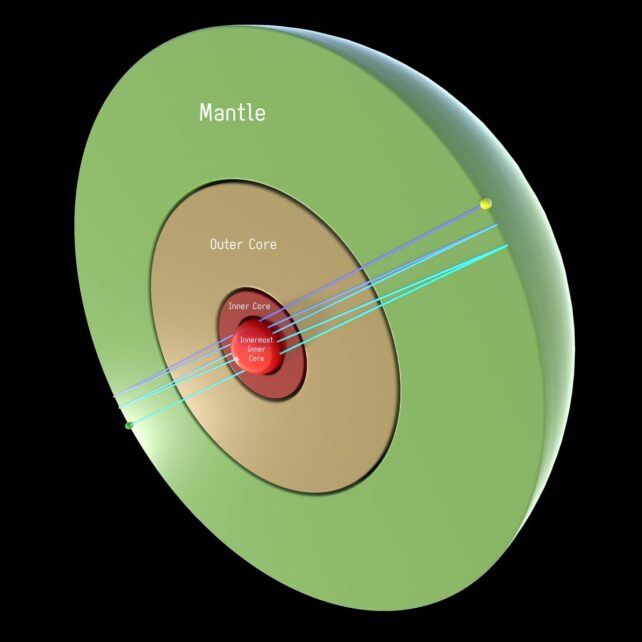Our home planet is seeming more like a jawbreaker the more we learn about its interior.
A new analysis of Earth's innards suggests the presence of an inner core within the inner core – a dense ball of iron at the very center of our planet.
This could reveal some previously unknown details about the history of Earth's formation and evolution, suggesting a significant global event early in our planet's history.
Earth's interior structure consists of a series of concentric layers, from the crust to the core. At the very center, with a radius of about 1,227 kilometers (762 miles) is the inner core – the densest part of our planet, a solid ball mostly composed of iron and nickel, comprising less than 1 percent of Earth's volume.
This inner core is like a time capsule of Earth's history.
As the inner core grows, the solidification process releases heat and light that drives convection in the outer liquid core – the engine that powers the dynamo that converts kinetic energy into magnetic energy and maintains Earth's global magnetic field. That magnetic field is thought to keep harmful radiation out, and the atmosphere in, allowing life to thrive.
Changes in the inner core could thus trigger changes in the dynamo, which in turn could have implications for Earth's habitability over time.
But studying the inner core isn't easy. We can't just pop down there and drill into it; instead, we have to rely on seismic waves that bounce around inside the planet, changing as they encounter volumes of varying density.
Over 20 years ago, scientists identified the presence of another, even innerer core inside the inner core. They called it the innermost inner core, and other studies have supported its existence; but finding out more about it has remained difficult, partly because it's obscured by so many other layers, and partly because placing seismic stations in the right spots can be hard to do.
However, the number of global seismic monitoring stations around the globe is continuing to grow, constantly recording the imperceptible shuddering of the planet beneath our feet. And now seismologists Thanh-Son Phạm and Hrvoje Tkalčić from the Australian National University (ANU) in Australia have figured out a way to squeeze data on the innermost inner core out of those recordings.
"This study uses the ever-growing global seismograph network to produce global stacks for some significant seismic events individually," they write in their paper.
"This study reports a previously unobserved and unutilized class of seismological observations of reverberating waves through the bulk of the Earth along its diameter up to five times … To our knowledge, reverberations from more than two passages are hitherto unreported in the seismological literature."

When a giant quake rattles Earth, the event generates waves that ripple through the planet, traveling through and bouncing off structures within. This is how scientists have obtained such a detailed map of what's inside Earth.
But when the seismic waves hit a boundary, the wave that bounces off – a reverberation, like an earthquake "echo" – is much weaker. Previously, scientists had not been reported more than two passages of a seismic event through the planet.
By stacking the data – adding a collection of seismic signals together into a single trace – Phạm and Tkalčić were able to amplify the signal from several major seismic events, thus breaking this record. For the first time, they identified three-, four-, and five-fold seismic reverberations, which in turn allowed a more detailed probe of the inner core than previously achieved.
The different travel times of pairs of waves inferred the presence of the innermost inner core no wider than 650 kilometers (404 miles) across, made of dense iron. This structure could be the result of a fundamental change in the growth of the inner core at some point in Earth's past.
The research, Phạm and Tkalčić say, means we now have sufficient evidence of the existence of the innermost inner core, and that future efforts should focus on characterizing it, the outer inner core, and the boundary between the two. And it demonstrates that the answers we seek may be already waiting in the data for someone to uncover.
"The findings reported here are a consequence of the unprecedentedly growing volume of digital waveform data and will hopefully inspire further scrutiny of existing seismic records for revealing hidden signals that shed light on the Earth's deep interior," they write.
The findings have been reported in Nature Communications.
https://news.google.com/rss/articles/CBMibGh0dHBzOi8vd3d3LnNjaWVuY2VhbGVydC5jb20vYWZ0ZXItYS0yMC15ZWFyLXNlYXJjaC1zY2llbnRpc3RzLWhhdmUtZmluYWxseS1mb3VuZC1lYXJ0aHMtdHJ1ZS1pbm5lcm1vc3QtY29yZdIBAA?oc=5
2023-02-21 16:00:47Z
CBMibGh0dHBzOi8vd3d3LnNjaWVuY2VhbGVydC5jb20vYWZ0ZXItYS0yMC15ZWFyLXNlYXJjaC1zY2llbnRpc3RzLWhhdmUtZmluYWxseS1mb3VuZC1lYXJ0aHMtdHJ1ZS1pbm5lcm1vc3QtY29yZdIBAA
Bagikan Berita Ini















0 Response to "After a 20-Year Search, Scientists Have Finally Found Earth's True Innermost Core - ScienceAlert"
Post a Comment